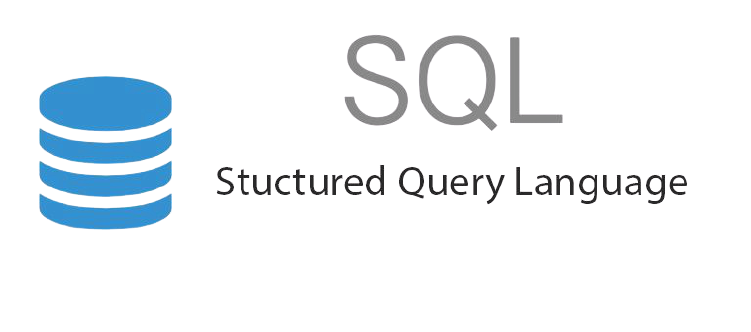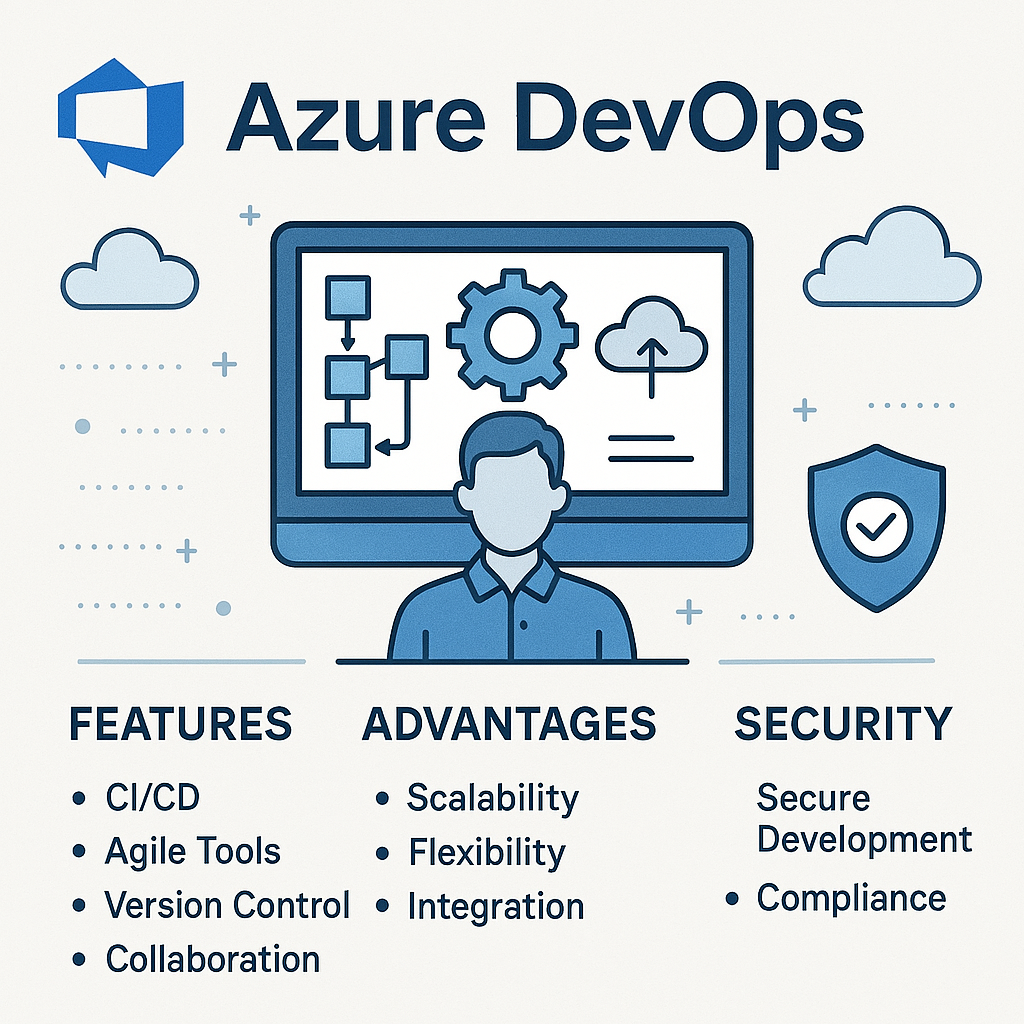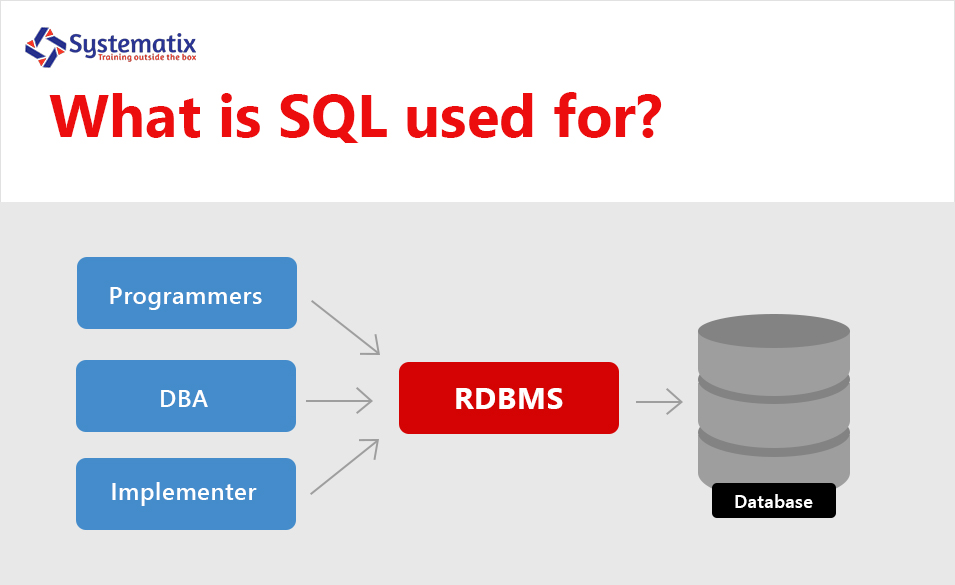
I. Introduction to SQL
What is SQL
SQL stands for Structured Query Language and is a programming language used for managing and manipulating relational databases. It is widely used in the field of data management and is the standard language for handling data in a relational database management system (RDBMS). SQL allows users to perform various operations on databases, such as creating, updating, and deleting data, as well as retrieving and transforming data for analysis and reporting. It provides a standardized way to interact with databases and is supported by all major database management systems.
Why is SQL important
SQL is important for several reasons:
1. Data Manipulation: SQL allows users to insert, update, and delete data in a database, making it a powerful tool for managing and organizing information.
2. Data Retrieval: SQL enables users to retrieve specific data from a database using queries. This allows for efficient and targeted data analysis and reporting.
3. Data Control: SQL provides mechanisms for controlling access to data, ensuring that only authorized users can perform certain operations on the database.
4. Data Transformation: SQL allows for the transformation of data through various functions and operators. This enables users to reformat and manipulate data for specific purposes.
5. Database Administration: SQL is essential for tasks related to database administration, such as creating, modifying, and deleting database objects, as well as managing user permissions and security.
In summary, SQL is important because it provides a standardized and efficient way to manage, retrieve, and manipulate data in a relational database. It is a fundamental tool for data management and analysis in various industries.
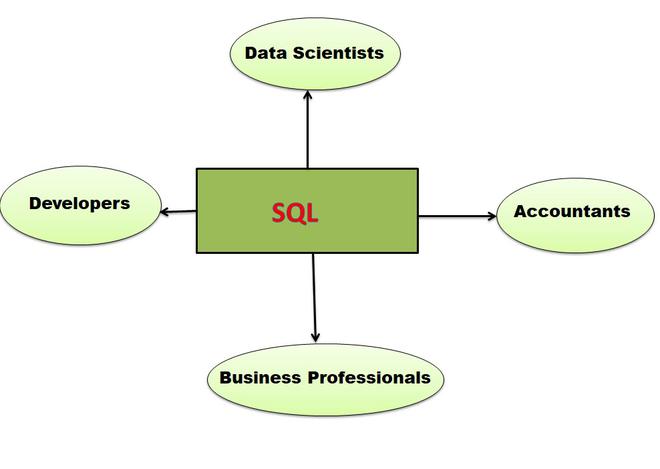 Source: media.geeksforgeeks.org
Source: media.geeksforgeeks.orgII. SQL Basics
SQL Syntax
SQL stands for Structured Query Language, and it is a programming language used for managing and manipulating relational databases. The syntax of SQL is straightforward and easy to understand, even for beginners. Some key elements of SQL syntax include:
1. Keywords: SQL uses specific keywords and commands to perform different tasks, such as SELECT, INSERT, UPDATE, DELETE, and CREATE.
2. Tables: A relational database consists of tables, which are used to store and organize data. SQL syntax is used to create, modify, and query these tables.
3. Queries: SQL syntax allows for the execution of queries on the database tables. Queries allow users to retrieve, insert, update, and delete data from the tables.
Common SQL Commands
There are several common SQL commands that are frequently used in database management:
1. SELECT: This command is used to retrieve data from one or more tables in the database. It allows users to specify the columns they want to retrieve and apply conditions for filtering the data.
2. INSERT: This command is used to insert new data into a table. Users can specify the values they want to insert into specific columns of the table.
3. UPDATE: This command is used to modify existing data in a table. Users can specify the columns and values they want to update, as well as apply conditions to update specific rows.
4. DELETE: This command is used to delete data from a table. Users can specify conditions to delete specific rows or delete all rows from the table.
5. CREATE: This command is used to create a new table in the database. Users can specify the table name, columns, data types, and other properties of the table.
6. DROP: This command is used to delete an entire table from the database. Users must be careful while using this command, as it permanently deletes all the data in the table.
SQL is an essential tool for managing and querying relational databases. Its simplicity and versatility make it a popular choice for developers and database administrators. Learning SQL can be beneficial for anyone working with databases or aspiring to work in the field of data management.
 Source: images.datacamp.com
Source: images.datacamp.comIII. Data Manipulation with SQL
SQL, or Structured Query Language, is a programming language used for managing and manipulating relational databases. It provides a set of commands that allow users to interact with a database, retrieve and manipulate data, and perform various operations on the data. Here are some key aspects of data manipulation with SQL:
Selecting Data
The SELECT statement is used to retrieve data from one or more tables in a database. It allows users to specify which columns and rows they want to retrieve. Users can also use SQL functions to perform calculations or data transformations on the retrieved data.
Filtering and Sorting Data
SQL provides the WHERE clause for filtering data based on specified conditions. Users can add conditions to the WHERE clause to retrieve only the desired data. The ORDER BY clause is used to sort the retrieved data in ascending or descending order based on one or more columns.
Updating and Deleting Data
SQL also allows users to update and delete data in a database using the UPDATE and DELETE statements, respectively. The UPDATE statement is used to modify existing data in one or more rows, while the DELETE statement is used to remove one or more rows from a table.
SQL is essential in data management as it provides a standardized way to query and manipulate data in databases. It allows users to retrieve relevant data, filter and sort it, and perform updates or deletions as needed. With the ability to handle large amounts of data efficiently, SQL is widely used in various industries for data analysis, reporting, and decision-making processes.
To learn more about SQL and its importance, you can visit the SQL Wikipedia page.
 Source: opentextbc.ca
Source: opentextbc.caIV. Data Definition with SQL
Creating and Modifying Tables
SQL allows users to create and modify tables within a database. Tables are used to store and organize data in a structured format. With SQL, users can define the columns and data types for each table, as well as set constraints and define primary and foreign keys. This allows for efficient data storage and retrieval.
Some key features of creating and modifying tables with SQL include:
- CREATE TABLE: SQL provides a syntax for creating new tables in a database. Users can specify the table name, column names, and data types.
- ALTER TABLE: SQL allows users to modify existing tables by adding or removing columns, modifying column data types, and setting constraints.
- PRIMARY KEY: SQL provides a way to define a primary key for a table, which ensures that each row in the table is uniquely identified.
- FOREIGN KEY: SQL also allows users to define relationships between tables using foreign keys. This helps maintain data integrity and enables efficient querying of related data.
Defining Relationships between Tables
In addition to creating and modifying tables, SQL allows users to define relationships between tables. This is important when dealing with complex data structures or when data needs to be organized in a relational manner. Some common types of relationships include:
- One-to-One: A one-to-one relationship exists when each record in one table is related to exactly one record in another table.
- One-to-Many: A one-to-many relationship exists when each record in one table can be related to multiple records in another table.
- Many-to-Many: A many-to-many relationship exists when each record in one table can be related to multiple records in another table, and vice versa.
By defining these relationships using SQL, users can ensure data integrity and efficiently query and retrieve related data from multiple tables.
To sum it up, SQL provides the tools necessary to create and modify tables within a database, as well as define relationships between tables. This makes SQL an essential tool for managing and organizing data effectively.
 Source: thetapacademy.com
Source: thetapacademy.comV. Data Querying with SQL
SQL (Structured Query Language) is a programming language that is widely used for managing and manipulating data in relational databases. It provides a standardized way to interact with databases, allowing users to retrieve, insert, update, and delete data.
Simple Queries
One of the main uses of SQL is for querying databases to extract specific information. With SQL, you can write simple queries to perform tasks such as:
- Retrieving data from a single table based on specific conditions
- Sorting and filtering data
- Calculating and aggregating data using functions
SQL queries are concise and efficient, allowing users to quickly retrieve the desired information from vast amounts of data.
Joins and Subqueries
SQL also provides the ability to combine data from multiple tables using joins. Joins allow users to link related data in different tables based on common columns, enabling the extraction of meaningful insights from complex data relationships.
Subqueries, on the other hand, allow users to nest queries within queries, providing a powerful way to perform complex operations and retrieve specific subsets of data.
By leveraging the capabilities of SQL, users can efficiently retrieve and analyze data, making it an invaluable tool for data analysis and decision-making in various industries.
To learn more about SQL and its features, you can visit the SQL Wikipedia page.
 Source: techdifferences.com
Source: techdifferences.comVI. Data Control with SQL
Granting and Revoking Permissions
Granting and revoking permissions is an essential aspect of managing data security in SQL. With SQL, database administrators can control access to specific tables, views, and procedures, ensuring that only authorized individuals have the necessary permissions to view, modify, or delete data.
Using SQL’s GRANT statement, administrators can assign various privileges to users or roles, such as SELECT, INSERT, UPDATE, DELETE, and EXECUTE. This ensures that users have the appropriate level of access based on their roles within the organization.
Conversely, the REVOKE statement in SQL allows administrators to remove or revoke specific permissions from users or roles. This feature is crucial for maintaining data integrity and preventing unauthorized access to sensitive information.
Managing Users and Security
SQL provides robust features for managing users and ensuring data security within a database. Administrators can create, modify, and delete user accounts, as well as define password policies for enhanced security.
Additionally, SQL allows for the creation of roles, which can simplify and streamline the management of multiple users with similar access requirements. Roles can be granted specific permissions, and users can be assigned to these roles, reducing the need for individual permission assignments.
Furthermore, SQL supports the use of encryption algorithms and techniques to protect sensitive data stored within the database. This helps safeguard information from unauthorized access or data breaches, ensuring the privacy and integrity of critical data.
Overall, SQL’s data control features are vital for managing user access, maintaining data security, and protecting sensitive information within a database. This aspect of SQL is crucial in ensuring the confidentiality, integrity, and availability of data for organizations across various industries.
For more information on SQL and its features, you can visit this Wikipedia article.
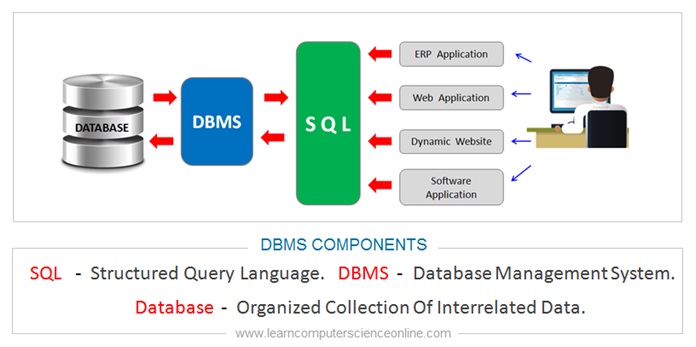 Source: www.learncomputerscienceonline.com
Source: www.learncomputerscienceonline.comVII. SQL in Database Management Systems
Popular Database Management Systems that use SQL
SQL (Structured Query Language) is a programming language that is used to manage and manipulate relational databases. Many popular database management systems (DBMS) utilize SQL as the standard language for interacting with the database. Some of the most widely used DBMS that use SQL include:
- MySQL: MySQL is an open-source DBMS that is widely used for web development and powering dynamic websites.
- Oracle Database: Oracle Database is a powerful and versatile DBMS that is trusted by many large-scale enterprises for managing their data.
- Microsoft SQL Server: SQL Server is a DBMS developed by Microsoft and is commonly used in Windows-based environments.
- PostgreSQL: PostgreSQL is a highly-extensible open-source DBMS known for its reliability and robustness.
- SQLite: SQLite is a lightweight and serverless DBMS that is often used in mobile app development and embedded systems.
Advantages of using SQL in Database Management Systems
There are several advantages of using SQL in database management systems:
- Standardization: SQL provides a standardized way of accessing and manipulating data in relational databases, making it easy to work with different DBMS.
- Flexibility: SQL allows for complex queries and operations to be performed on the database, enabling developers to extract valuable insights and create custom reports.
- Efficiency: SQL is optimized for managing large amounts of data efficiently, allowing for fast retrieval and manipulation of data.
- Data Integrity: SQL includes features and constraints that help maintain data integrity, ensuring that the data remains accurate and consistent.
- Scalability: With the ability to handle large volumes of data, SQL-based DBMS can scale to accommodate the growing needs of an organization.
Overall, SQL plays a crucial role in the management and manipulation of relational databases, empowering organizations to efficiently and effectively store, access, and analyze their data.
 Source: s3-us-east-2.amazonaws.com
Source: s3-us-east-2.amazonaws.comVIII. SQL in Data Analytics and Business Intelligence
How SQL is used in Data Analysis
SQL (Structured Query Language) plays a crucial role in data analysis. It allows analysts to extract, manipulate, and analyze data in relational databases efficiently. Here are some ways SQL is used in data analysis:
1. Data Retrieval: SQL helps analysts retrieve specific data from large databases by writing queries that allow them to filter and aggregate data based on certain conditions or criteria.
2. Data Transformation: SQL provides functions and commands that allow analysts to transform and manipulate data. They can perform calculations, create new variables, and reorganize data structures to fit their analysis requirements.
3. Data Cleaning: SQL allows analysts to clean and preprocess data by eliminating duplicate records, removing unnecessary columns, and handling missing values.
4. Data Aggregation: SQL allows analysts to aggregate data by applying functions such as SUM, AVG, COUNT, and GROUP BY, enabling them to gain insights into various metrics and trends.
5. Data Joins: SQL allows analysts to combine data from multiple tables using join operations, enabling them to create comprehensive datasets for analysis.
How SQL is used in Business Intelligence
Business Intelligence (BI) relies heavily on SQL for its data analysis and reporting capabilities. Here are some ways SQL is used in BI:
1. Report Generation: SQL queries are used to extract specific data from large datasets, which is then transformed into meaningful reports and visualizations.
2. Dashboard Creation: SQL queries are used to fetch and aggregate data from multiple sources, which is then used to create interactive dashboards that provide real-time insights.
3. Data Warehousing: SQL is used to design and manage data warehouses, which are large repositories of structured and integrated data that serve as a single source of truth for BI purposes.
4. Data Integration: SQL is used to integrate data from various sources, such as databases, spreadsheets, and external APIs, into a unified system for analysis.
5. Ad-Hoc Analysis: SQL allows BI analysts to perform ad-hoc analysis on large datasets, allowing them to explore data, identify patterns, and make data-driven decisions.
Overall, SQL is a powerful and essential tool in data analysis and business intelligence, enabling professionals to efficiently manage and analyze vast amounts of data to gain valuable insights and drive informed decision-making processes.
.jpg) Source: www.analyticssteps.com
Source: www.analyticssteps.comIX. SQL in Application Development
Using SQL in Backend Development
SQL (Structured Query Language) is an essential tool in backend development for managing and organizing data in applications. Here are some key ways in which SQL is used in backend development:
1. Database Management: SQL is used to create, modify, and manage databases. It allows developers to define the structure of the database, create tables, establish relationships between them, and define constraints and rules.
2. Data Manipulation: SQL provides powerful tools for querying and manipulating data stored in databases. Developers can use SQL statements to retrieve, insert, update, and delete records, making it easy to perform various operations on data.
3. Data Security: SQL includes features for implementing data security measures, such as user authentication and access control. Developers can use SQL to create user accounts, assign privileges, and enforce security policies to protect sensitive data.
4. Performance Optimization: SQL allows developers to optimize query performance by using indexing techniques, creating views, and writing efficient queries. These optimizations improve the speed and efficiency of data retrieval and manipulation operations.
Integrating SQL with Programming Languages
SQL can be integrated with various programming languages to develop robust and dynamic applications. Some popular programming languages that support SQL integration include:
1. Java: Java provides libraries and frameworks like Hibernate and JDBC (Java Database Connectivity) that allow developers to interact with databases using SQL queries.
2. Python: Python offers libraries such as SQLAlchemy and Django ORM (Object-Relational Mapping) that provide SQL integration and simplify database operations.
3. C#: C# developers can use frameworks like Entity Framework to work with SQL databases. Entity Framework provides an object-relational mapping approach, enabling developers to work with SQL databases using C# objects.
4. PHP: PHP has built-in support for SQL integration through extensions like PDO (PHP Data Objects) and MySQLi. These extensions provide APIs for executing SQL queries and managing databases in PHP applications.
By integrating SQL with programming languages, developers can leverage the power of SQL to interact with databases and handle data operations seamlessly within their applications.
SQL is a vital tool in application development due to its ability to manage and manipulate data efficiently. Its integration with programming languages empowers developers to build robust and scalable applications that rely on the effective handling of data.
 Source: p.calameoassets.com
Source: p.calameoassets.comX. Conclusion
Importance of SQL in data management and application development
In conclusion, SQL (Structured Query Language) is a crucial tool in data management and application development. It provides a standardized way to interact with relational databases and retrieve, manipulate, and store data. Here are some key reasons why SQL is important:
1. Data Management: SQL allows users to perform various operations on databases, such as creating tables, inserting, updating, and deleting records, and executing complex queries. It provides a structured and efficient way to manage and organize large volumes of data.
2. Application Development: SQL is widely used in the development of web and desktop applications. It enables developers to integrate databases into their applications, store and retrieve data, and perform necessary operations efficiently.
3. Data Analysis and Reporting: SQL’s ability to retrieve specific data from databases makes it an essential tool for data analysis and reporting. It allows users to write queries that extract valuable insights from large datasets, helping businesses make informed decisions.
4. Database Security: SQL includes security features that protect sensitive data stored in databases. It allows users to define user access permissions, implement data encryption, and ensure data integrity.
5. Scalability and Performance: SQL databases are known for their scalability and performance. They can handle increased data volumes and complex queries efficiently, ensuring fast and reliable access to data.
Overall, SQL plays a vital role in data management and application development. Its standardized syntax and wide support make it a powerful language for managing and analyzing data, making it an essential skill for individuals and businesses in the digital age.

